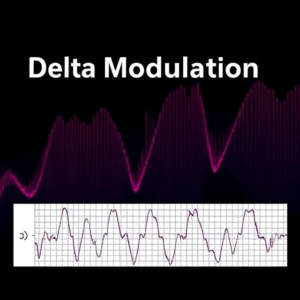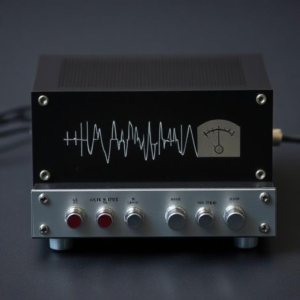Delta Modulation (DM) is a signal encoding technique used in data transmission, primarily for the purpose of compressing and simplifying the representation of analog signals. It’s a type of differential encoding where the goal is to represent an analog signal (such as voice, music, or any continuous signal) in a way that reduces the amount of data needed to transmit the signal, making it more efficient for digital communication.

What is Delta Modulation?
Delta Modulation is a method of converting an analog signal into a digital signal by approximating the original signal’s values using a sequence of 1-bit changes (also called “deltas”) rather than encoding the full value of the signal at each point in time. The main idea behind Delta Modulation is to record the difference between the current signal value and the previous signal value. This allows for simpler, more efficient encoding, as only the difference (or change) is stored or transmitted.
How Delta Modulation Works:
- Signal Sampling: The first step in Delta Modulation is to sample the analog signal. Unlike Pulse Code Modulation (PCM), which records the exact value of the signal at each sampling point, Delta Modulation only records the change (delta) between the current sample and the previous one.
- Delta (Difference) Calculation: At each sample point, the difference between the current signal value and the previous signal value is calculated. This difference is compared to a predefined threshold (called the step size, ΔDelta).
- Quantization: If the difference is greater than the step size ΔDelta, a “1” is recorded (indicating the signal has increased), and if the difference is smaller, a “0” is recorded (indicating the signal has decreased or stayed the same).
- Binary Output: The resulting output is a series of 1s and 0s representing whether the signal is going up or down (or remaining unchanged) compared to the previous sample. This binary sequence is transmitted or stored.
Key Components of Delta Modulation:
- Step Size (ΔDelta): The step size determines how large a change in the signal must occur for the system to record a “1” or “0.” A larger step size means the system can track bigger changes but might miss small variations in the signal. A smaller step size will more closely follow the original signal, but may result in a larger number of bits and more data to transmit.
- Sampling Rate: The rate at which the analog signal is sampled also impacts the quality of the modulation. Higher sampling rates provide better approximations of the original signal, while lower rates may introduce errors.
- 1-bit Encoding: Delta Modulation only uses 1-bit for each sample (either a “1” or a “0”), which makes it a very efficient method for transmitting or storing data compared to other methods that use more bits per sample.
Delta Modulation Process in Detail:
- Initialization: The process starts with an initial value, often set to the starting value of the analog signal at time t=0t = 0.
- At each sample point:
- The system calculates the difference (delta) between the current signal sample and the previous value.
- It compares this difference to the step size ΔDelta.
- If the difference is greater than or equal to ΔDelta, the system sends a “1” (indicating the signal has increased).
- If the difference is less than ΔDelta, the system sends a “0” (indicating the signal has either decreased or remained stable).
- Reconstruction: After transmission, the receiver reconstructs the signal by interpreting the 1s and 0s. It adds or subtracts the step size from the previous sample to estimate the current signal value.
Example of Delta Modulation:
Let’s consider an example where we have a simple analog signal and apply Delta Modulation with a step size ΔDelta of 1 unit.
- The analog signal starts at value 3 (initial signal value).
- If the signal increases by more than 1 unit, the system will send a “1”.
- If the signal decreases by more than 1 unit, the system will send a “0”.
Let’s say the analog signal increases to 4, then to 5, then drops back to 3, and then increases again to 6:
- At the first step, the signal changes from 3 to 4. Since the change is 1 unit (which is equal to ΔDelta), we send “1” (signal increased).
- At the next step, the signal increases from 4 to 5. This is another change of 1 unit, so we send “1”.
- Next, the signal drops from 5 to 3, which is a decrease of 2 units, so we send “0” (signal decreased).
- Finally, the signal increases from 3 to 6, a change of 3 units, so we send “1”.
The transmitted bitstream would be: 1, 1, 0, 1.
Advantages of Delta Modulation:
- Simplicity: Delta Modulation is relatively simple to implement compared to other modulation techniques like Pulse Code Modulation (PCM). It only uses 1 bit per sample, which reduces the amount of data required.
- Efficiency: Because only the change in the signal is encoded, Delta Modulation is more efficient in terms of data usage for certain types of signals.
- Lower Bandwidth: The 1-bit encoding reduces the bandwidth required for transmission, making it suitable for low-bandwidth communication systems.
Disadvantages of Delta Modulation:
- Granularity (Step Size): If the step size ΔDelta is too large, the signal reconstruction will be less accurate, causing a “staircase effect.” The signal will be approximated, but small variations may be missed. If ΔDelta is too small, more bits will be needed, reducing the efficiency.
- Slope Overload: When the signal changes too quickly (a steep slope), Delta Modulation might not be able to track it properly. This is called slope overload, and it occurs because the system cannot encode large changes within a single step.
- Granular Noise: When the signal changes slowly or remains constant, Delta Modulation may still produce a noisy output because the step size is not small enough to match the signal’s slow variations. This is called granular noise.
Variants of Delta Modulation:
- Adaptive Delta Modulation (ADM): To address the problem of poor resolution for rapidly changing signals, Adaptive Delta Modulation dynamically adjusts the step size ΔDelta based on the signal’s characteristics. When the signal changes slowly, the system reduces ΔDelta, and when the signal changes rapidly, it increases ΔDelta.
Applications of Delta Modulation:
- Speech Encoding: Delta Modulation is used in speech transmission systems (like in telephony or voice compression) because speech signals often change smoothly and Delta Modulation efficiently captures these changes.
- Audio Compression: It can be used to reduce the data rate needed for audio signals in situations where bandwidth is limited.
- Digital Signal Processing: Delta Modulation is useful in situations where the signal does not require exact precision but can tolerate approximations, such as low-quality audio or simple sensor data.
Summary:
- Delta Modulation (DM) is a technique for encoding an analog signal into a digital format by transmitting the difference between successive signal samples.
- It uses only 1 bit per sample, making it a simple and efficient encoding scheme.
- The technique can suffer from slope overload (for rapidly changing signals) and granular noise (for slowly changing signals).
- Adaptive Delta Modulation (ADM) improves upon DM by adjusting the step size based on the signal’s behavior.
In simple terms, Delta Modulation is like trying to draw an approximation of a curve by only recording whether the curve is going up or down at each point, and by how much. The accuracy of the approximation depends on the step size and how fast the signal changes.











